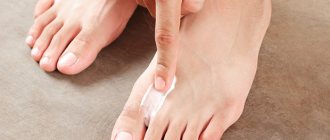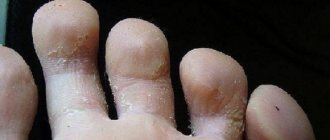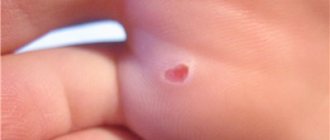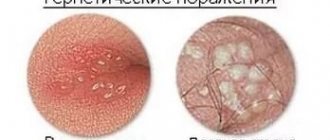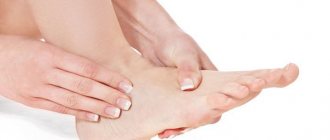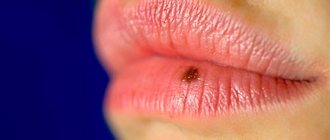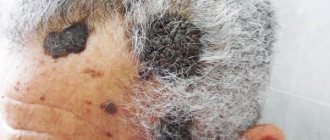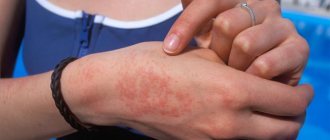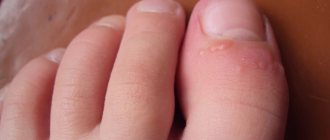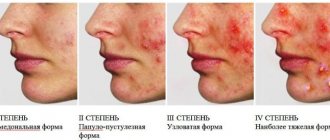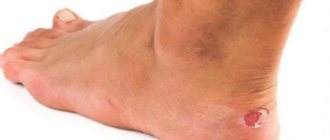The skin of your hands is constantly exposed to external factors. Detergents, temperature changes, dirt, dust and much more affect the condition of the dermis, and even with careful care, cracks can occur between the fingers. The layer of skin here is much thinner than in other areas of the palm and fingers, and the joints are constantly bent, which causes the skin to stretch and relax. The appearance of cracks causes pain, discomfort and harms the performance of daily and professional duties. Why does this happen and what can be done to heal the skin?
Why does the skin between my fingers crack?
A person's skin speaks about his health
Skin is an indicator of a person’s internal health. Cracks can be caused by both external and internal factors.
The condition of the epidermis is affected by:
- regular contact with household chemicals - hand washing, washing dishes with a high content of surfactants, disinfecting the toilet with aggressive agents with a concentration of chlorine lead to a decrease in the elasticity of the skin;
- exposure to temperatures - interaction with ice water, antifreeze, freezing of hands in the wind and frost excessively dries out the top layer of skin;
- fungal pathologies are the most common culprit of cracks between the phalanges of the fingers; main diseases: candidiasis of the hands and dermatophytosis (in addition to bursting skin, the patient is bothered by severe itching, peeling, rash and redness);
- contact dermatitis - symptoms are similar to a fungal disease, since the skin reacts to the allergen with swelling, rash and irritation;
- eczema - most often, cracks between the fingers suggest the presence of dry eczema on the hands;
- palmoplantar psoriasis - rough scaly plaques are localized between the fingers, on the palms and hands.
The appearance of cracks is influenced by age (in women after menopause, the skin becomes dry and prone to inflammation due to decreased hormone production), weak immunity, lack of vitamins A, P and C, as well as taking certain medications (to lower blood pressure or cholesterol levels).
Additional causes include thyroid disease and diabetes.
Read: Seizures need to be treated comprehensively
Diseases of fungal etiology
One of the equally common reasons why the epidermis between the fingers itches is a fungal infection. It is transmitted, as a rule, through personal contact: through handshakes, the use of hygiene or household items of an infected person, during hugs, etc.
It is noteworthy that the most intense itching and peeling of the skin on the hands is between the fingers. This is a favorite place for fungi, which subsequently becomes covered with pimples prone to ulceration.
Read what products help remove peeling at https://moninomama.ru/vodyanistyie-puzyrki-na-rukah.html
One of the types of skin mycoses is candidiasis. The danger of this disease also lies in the fact that it can affect not only the epidermis, but also the mucous membranes. Itching on the fingers under such circumstances is accompanied not only by peeling, but also by the appearance of white spots - they are the main sign of the presence of Candida fungus.
Features of therapy
Redness and peeling between the fingers are only symptoms that are completely useless to fight if the root cause of their occurrence has not been eliminated. But the disease can only be cured with the help of special antimycotic agents:
- tablets,
- ointments,
- creams,
- sprays or aerosols.
The following medications have a good reputation:
- Nystatin,
- Fluconazole,
- Clotrimazole,
- Ketoconazole,
- Itraconazole,
- Futsis, etc.
They cannot be used without a doctor’s prescription, especially if we are talking about their systemic use. Dryness and redness between the fingers caused by fungal pathologies does not go away quickly, and this must be remembered. Under no circumstances should therapy be interrupted when symptoms have just begun to disappear. If you do this, the disease will make itself felt with redoubled force.
Important! No folk remedies for fungal peeling between the fingers alone will help cope with the disease. Herbal infusions can be used for symptomatic therapy, for example, for severe irritation or pain. But they will not help eliminate this or that type of fungus; instead, the disease will enter an advanced stage.
Diagnostic research methods
In most cases, an external examination by a dermatologist is sufficient to make a diagnosis. If allergic dermatitis is suspected, a sensitivity test to possible allergens is performed.
If you suspect a fungal infection, you need to determine its type.
If a fungus is suspected, it is necessary to determine the type of pathogen. To do this, skin scraping is done for bacteriological analysis. As an additional analysis, a test for antibodies to fungi is prescribed.
Fungal skin infections have characteristic symptoms:
- initially, bubbles appear between the fingers;
- the skin in this place begins to swell;
- bubbles turn into erosions and become covered with a white coating;
- over time, the ulcers form shallow cracks;
- Bursting skin due to fungal infections causes severe pain.
If an allergic or fungal origin of the cracks is excluded, an analysis for the presence of helminths, a biochemical blood test, and an examination of the endocrine organs and digestive tract are prescribed.
Psoriasis will be indicated by the appearance of red calluses that become covered with cracks. The skin at the site of the lesion is rough and dense. To avoid confusing psoriasis with eczema or fungus, a biopsy is used.
Characteristic signs help to diagnose interdigital eczema: intense night itching that prevents the patient from falling asleep and weeping erosions.
Preventing cracks between fingers
If you have cracks in your hands, you need to take proper care of them.
Once cracks are detected, the skin must be thoroughly cared for. Minimum activities include:
- exclude the use of antibacterial household chemicals - hand soap must have a neutral pH environment, washing hands with cosmetics containing glycerin is allowed, and after washing, dry hands with a soft towel;
- use gloves - rubber gloves will protect the skin of your hands from the influence of chemicals contained in household chemicals; in cold weather, be sure to wear mittens or gloves to avoid frostbite;
- hand cream - in winter, creams with a greasy texture that create a protective film are recommended; in summer, it is advisable to protect your palms from ultraviolet radiation using a cream with SPF sunscreen effect.
- good nutrition - to exclude the cause of vitamin deficiency, it is necessary that the diet is not meager and includes cereals, dairy products, fruits and vegetables, foods with vitamins A and E, nuts and olive oil.
Read: Paget's disease of bone: what is important to know about it
To treat deep cracks, dermatologists have invented a special “superglue” BF-6. A few drops of medical glue are applied to the crack. After a few minutes it hardens and remains on the skin for 5 to 7 days. During this period, no additional skin treatment is required.
If the cracks itch and do not heal after the manipulations, most likely the cause lies in an infectious or allergic disease.
Effective treatment with folk remedies
Baths
The selection of therapeutic agents for skin problems must be approached especially responsibly. A good hand cream, ointment, gel should be safe. It is necessary to select remedies that will not only relieve symptoms, but also eliminate the cause of the problem and lead to stable and rapid remission.
https://www.youtube.com/watch?v=QXBmA0cvpro
Often, special medicinal ointments are used to eliminate flaking of the skin of the hands. They contain vitamins B and C. With their help, you can protect the skin from all kinds of negative influences, they relieve irritation, nourish and soften your hands. Often the effectiveness of medicinal ointments is influenced by the presence of antiseptics and antibiotics as components, and in addition, extracts of medicinal plants.
Recently, experts have advised the use of combination drugs, for example, Klenzit. This gel perfectly penetrates into the deep layers of the inflammation. As a result of exposure to the components adapalene and clindamycin, which destroy bacteria, the peeling area is reduced and a positive effect is achieved.
Therapeutic creams that protect against external irritants and restore moisture are quite effective. An excellent effect can be observed after using vitamin products that contain components of medicinal plants. For example, a good hand cream is Boro-Plus.
Dehydrated and dry skin should be supported by moisturizing creams that are selected correctly. Products should be applied after each contact with water, and in winter also before going out into the fresh air. They should contain ingredients such as glycerin, silicone, and mineral oils.
For irritated skin, it is useful to make special baths from various natural products, for example, sauerkraut brine or potato juice. They are mixed in equal quantities or used separately. Chop the potatoes on a fine grater, mix them with cabbage brine and put your hands in there for 30 minutes.
In addition, it is useful to soak your hands for 15 minutes before going to bed in a mixture of a decoction of potatoes, celery and a small amount of vegetable oil. Also effective are baths made from a decoction of linden blossom, nettle, sage and other plants.
Hand skin can be nourished with oil wraps. For this purpose, cotton gloves are used, which are pre-impregnated with vegetable oil heated in a water bath. Knitted or woolen gloves are worn on top. After 1.5 hours, remove everything and wipe off the oil from your hands. You can also moisturize your skin using homemade masks made from cottage cheese, potatoes, oatmeal and fruits.
How are cracked hands treated?
But the skin between the fingers does not always crack due to overheating or too much dishwashing. Much more common are cracks caused by fungi, allergens or psoriasis.
Systemic ointments are used to treat fungus
To treat fungal infections, systemic drugs and creams for external use are used:
- Clotrimazole, Miconazole
- Bifonazole, Fenticonazole
- Lamisil, Terbinafine
- Nystatin, Caspofungin.
It is possible to prescribe a solution of fucorcin, miramistin, chlorhexidine to lubricate cracks, as well as a diet limiting sweet foods. In case of allergic nature of cracks, it is advisable to use:
- antihistamines to relieve swelling and itching (Diazolin, Loratadine, Cetrin, Erius);
- antipruritic ointments and creams (Psilo-balm, Fenistil-gel, Gistan, La-kri);
- creams based on glucocorticoids (hormonal agents quickly heal the skin, but have an addictive effect, they are used only for their strict purpose: Advantan, Elokom, Lokoid, Flucinar).
Skin that has burst as a result of psoriasis is difficult to treat. In this case, products with salicylic acid, combination drugs with corticoids, medicinal ointments with tar or grease are used.
For hormonal imbalance, treatment is based on treatment of the underlying disease.
Fungus
Mycosis is considered one of the most common skin diseases. It occurs due to the ingress and proliferation of various fungi. Most often they settle on the nail plates and between the fingers. Initially, the disease manifests itself in the form of severe itching and painful changes in the edge of the nail. Then the nail becomes dull, thickens and becomes brittle.
Your palms may also begin to sweat. Then spots of different colors and sizes appear. The color of the rash varies, ranging from bluish to pale pink. The skin between the fingers peels off, begins to get wet, and cracks form. The plates on the nails peel off, become yellow and brittle.
https://www.youtube.com/watch?v=xdMZvt6QcXw
People with mycosis do not have access to a full life. Therefore, even minor violations of the skin between the fingers should be carefully examined and treated. Therapy is long and painstaking. Constant medical supervision and discipline on the part of the patient is necessary. Mycosis is easy to contract as it is transmitted between people and animals.
Eczema as a cause of cracks between the fingers
It is worth starting treatment for eczema between the fingers as soon as possible, otherwise the outbreak of the disease will spread to the entire palm. After identifying eczema, it is advisable to cover your hands from direct sunlight, which contributes to the spread of the disease to healthy areas of the skin.
Cracks on your hands can be sprinkled with talc
At the initial stage, cracks between the fingers can be sprinkled with talcum powder or baby powder. An eczematous rash causes severe itching, so patients must be prescribed antihistamines. With chronic eczema, the cracks become very deep and extremely painful.
To heal cracks between the fingers, topical products are used:
- Boron-zinc paste
- Naftalan ointment
- Zinc ointments
- Silver nitrate solution
- 0.1% copper solution
- 5% diphenhydramine paste
Read: Treatment for lichen depends on its type!
Eczema that is stubbornly resistant to treatment can be treated with corticosteroid hormonal creams (Skin-cap, Celestoderm, Elokom). If the eczema is microbial, dermatologists prefer to prescribe drugs in combination with an antiseptic or antimycotic (Trimistin, Travocort).
In addition to topical use, it is necessary to use immunomodulators and vitamin complexes; sometimes it is advisable to take enterosorbents to reduce intoxication and sedatives.
Symptoms
It is necessary to distinguish between ordinary cracks and signals from the body about the presence of diseases. For example, deep, non-healing ulcers indicate diabetes; you should consult a doctor as soon as possible. It is very important to quickly notice an allergic reaction to detergents, otherwise you may develop dermatitis. Symptoms of an allergy to detergents:
- Dry fingers;
- Brittle nails;
- Severe itching between the fingers, peeling.
Photo - Cracks on fingers
Allergy to cold is a common occurrence in winter, but this fact does not make the disease any less dangerous than previous ones. This reaction can develop into a chronic phenomenon and occur even when washing dishes in cold water. What cracks on the fingers of women’s hands indicate this problem:
- Painful nodules on the pads;
- Cracks throughout the finger, especially on the phalanges;
- Dryness, itching, swelling of hands.
Sometimes bleeding ulcers appear from frost.
Video: why you need to wash your hands properly
